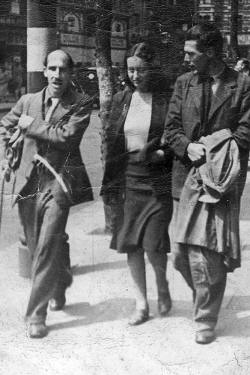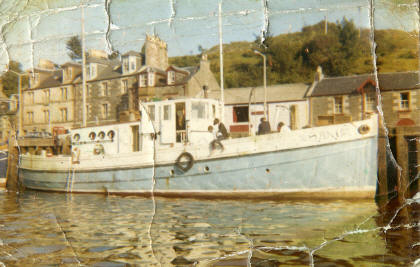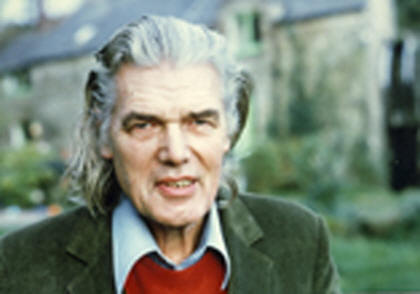|
|
| home | features | exhibitions | interviews | profiles | webprojects | gazetteer | links | archive | forum |
|
Denys Val Baker
Baker was, much to his chagrin, actually born in Poppleton, Yorkshire (in October 1917) where his father Valentine Baker was stationed as a pilot instructor during the Great War. He grew up in North Wales and Sussex and eventually lived with his parents in Surbiton. As a young man Denys developed an interest in writing, particularly the short story format which was much in vogue in the thirties and began to send off stories to magazines. Through his father’s contacts with the Harmsworth family Denys managed to get a job as a reporter on the Derby Evening Telegraph, one of the Harmsworth family’s regional titles, and stayed there for three years, later moving to London where he worked as a jobbing journalist on various trade papers. At the outbreak of war Denys, who was a lifelong pacifist and vegetarian, registered as a conscientious objector after facing a tribunal. By now he was also beginning to supplement his income through sales of short stories to London based literary magazines and a bit of freelance journalism, he also became secretary of a pacifist community in Camden Town.
Denys Val Baker’s own career as a writer of fiction really took off with the publication of his ‘Selected Stories’ a little stapled paperback around 1944 followed by the more substantial hardback ‘Worlds Without End’ in 1945 (with wood engravings by Biro) and then his first novel ‘The White Rock’ in the same year. Still only twenty seven he began to attract the usual plaudits such as “another D.H. Lawrence” that young writers were burdened with in those days, but ‘The White Rock’ sold very well and was republished in the U.S. and also in Holland. A second novel ‘The More We Are Together’ soon followed and then a third ‘The Widening Mirror’ in 1949 but by now he was concentrating on short stories - with a stream of stories being published in magazines or read on the B.B.C.’s ‘Morning Story’ spot. In fact, over the years he had well over 100 stories broadcast and became well known as a master of the genre.
West Cornwall in the late forties seems to have been a veritable cauldron of artistic talent, with many of the young painters and writers who were to establish the area’s reputation having moved there after the war (picture top left in the Castle Inn). The Cornish Review was a timely addition to the Cornish artistic scene and featured poems, short stories, articles, are now essential reading for historians of this period. Ever the optimist, Val Baker printed 2000 copies of the first Review (half of which he had eventually to set fire to) but the circulation in the end settled down to just under 1000 and the quarterly magazine managed to survive for three years and ten issues. Like most ventures of this kind the Review was not a great economic success and although it had great support from its readers and advertisers there were no funding organisations in those days to bear the losses. Many years later Val Baker revived the Review (in 1966) with much the same mixture, this time it lasted for twenty six issues until it folded in 1974 when South West Arts withdrew its funding. Through the Review’s two existences it became apparent that Cornwall needed such a magazine to feature the artistic and literary talent talent that flourishes in the county and it will be interesting to see how the new Cornish literary publication ‘Scryfa’ fares in the new century.
In 1954 the Val Bakers left St Hilary and moved to Ashford in Kent, (with the family of eight squashed into an old London taxi), and then to London in search of an easier life. However, although things did get a little easier, with better earnings and the stimulation of meeting old literary friends, Denys soon began to yearn once again for his adopted homeland. After a trial holiday in St Ives to test the water and after a particularly vicious dose of Asian Flu the family packed their bags and returned to Cornwall in the Autumn of 1957. That winter the Val Baker’s stayed first in a tiny rented cottage in Virgin Street St Ives and then in Church Place before in 1958 moving to the large and spectacular St Christophers house overlooking Porthmeor beach. Denys was much happier back in Cornwall, and St Ives at this time was once again a stimulating place to be. He and Jess soon merged back into the artistic community and their Boxing Day parties became legendary. Spotting a gap in the market Denys quickly began work on his acclaimed ‘Britain's Art Colony By The Sea’ which was the first of the many books on the St Ives artists when it came out in 1959. This was followed by several articles and a couple of T.V. films on this subject and as ever the short stories continued to flow. At this time Jess was running her successful pottery, and Denys, who because of his early training as a newspaperman was used to working under pressure, would sit typing away at his latest story in the corner of the showroom occasionally breaking off to sell a bowl or a coffee set to some happy holidaymaker. St Christophers’ proximity to the beach led to another source of income, a beach cafe which the family ran each summer with some success. In the winter however the house was exposed to wild Atlantic gales and several times the sea smashed its way past the beach doors and through the long house into the kitchen. This last occurrence provided Denys with the title for the first of his autobiographical books ‘The Sea’s in The Kitchen’ which was published in 1962 by Phoenix House and was to be his best selling book since the forties. The freedom of a free lance writer as described by Denys Val Baker in this book seemed, according to reviewer Kenneth Allsop in The Daily Mail, to be “...the freedom of a stoker in hell”.
In 1967 the family uprooted again and moved to The Old Sawmills (picture above right with daughter Demelza), a romantic, isolated building up a creek at Golant on the river Fowey approachable only by boat or along the China Clay Company’s railway and it was here that Denys settled for five years, writing in an old shed/studio on the sunny side of the creek. By now most of the elder children had set out on their ways but they often returned with friends and the Sawmills was always a very busy place. Denys’ mother Dilys had died in 1964 leaving him a legacy which made life a little easier and enabled him to at last indulge himself in a longtime ambition of buying a boat. Not for him a little sailing boat, Denys and Jess did a quick course in navigation and soon afterwards arrived in St Ives with the sixty two foot M.F.V. Sanu, an ex-navy supply tender which they bought for £4,500 near Southampton (picture below right). This was to transform their lives and was the reason they moved to Fowey where there was a safe mooring very near to their new house. From 1964 to 1980 Denys and his family were to spend the summers on Sanu. Early trips included The Channel Islands, The Scillies, up the Seine to Paris, Brittany, Scotland and Loch Ness, an epic trip through Scandinavia and finally across the Bay of Biscay and into the Mediterranian where Sanu was based for several years. This was not just an indulgence, the costs of the trips were covered by paying passengers and of course the many crises encountered, including two sinkings, provided good copy for articles in the yachting magazines and autobiographies.
Several novels were published in the seventies, including three of his best; ‘Company of Three’, ‘Barbican’s End’ and ‘Rose’ whilst seven collections of short stories came out in the same decade and there were sixteen new anthologies of stories - mostly for William Kimber. Denys Val Baker had always felt strongly that writers in Cornwall had been neglected and so he followed up his 1973 book ‘The Timeless Land’, in which discussed the creative spirit in the county, with a book that covered Cornwall’s literary history ‘A View from Land’s End’ published in 1980.
Of all this prodigious output only his 1959 book ‘Britain’s Art Colony By The Sea’ has been re-published so far but the original books are fetching good prices on the second-hand market and the popularity of his books was reinforced when with the introduction of Public Lending Rights in the year of his death the royalties put him in the top 120 of most borrowed authors of over 6000 who had registered. Martin Val Baker |
|
|




 With their ever increasing
family Denys and Jess moved from Trencrom to Penzance and then Sennen
Cove, all the time existing on little cheques from magazine and radio
editors for short stories, articles and the occasional book publication.
In 1950 with the help of a loan from his mother they managed to buy at
auction the seventeen room Old Vicarage, St Hilary, the house made
famous by Bernard Walke’s fine book ‘Twenty Years at St Hilary’. In
Walke’s time, (1912 to 1938), the vicarage had been a meeting place for
writers and artists such as Mackenzie, De la Mare, Shaw, Munnings the
Knights and the rest of the Newlyn group - and so it was again in Val
Baker’s years there. In fact Denys struck up a lifelong friendship with
Bernard Walke’s organist Frank Baker, also a writer, who provided a link
between the two eras. These were hard years for the Val Bakers as Denys
struggled to support a large family with an unpredictable income.
Sometimes there would be nothing for a fortnight and then an unexpected
cheque for fifty pounds would turn up. Jess took lessons with the potter
David Leach in Penzance and soon opened up a studio pottery, with Bill
Picard and Donald Swan as decorators, to provide a bit of extra income.
Twenty years later she was still running the Mask Pottery and providing
much needed support for her husband’s efforts to make a living as a
professional writer.
With their ever increasing
family Denys and Jess moved from Trencrom to Penzance and then Sennen
Cove, all the time existing on little cheques from magazine and radio
editors for short stories, articles and the occasional book publication.
In 1950 with the help of a loan from his mother they managed to buy at
auction the seventeen room Old Vicarage, St Hilary, the house made
famous by Bernard Walke’s fine book ‘Twenty Years at St Hilary’. In
Walke’s time, (1912 to 1938), the vicarage had been a meeting place for
writers and artists such as Mackenzie, De la Mare, Shaw, Munnings the
Knights and the rest of the Newlyn group - and so it was again in Val
Baker’s years there. In fact Denys struck up a lifelong friendship with
Bernard Walke’s organist Frank Baker, also a writer, who provided a link
between the two eras. These were hard years for the Val Bakers as Denys
struggled to support a large family with an unpredictable income.
Sometimes there would be nothing for a fortnight and then an unexpected
cheque for fifty pounds would turn up. Jess took lessons with the potter
David Leach in Penzance and soon opened up a studio pottery, with Bill
Picard and Donald Swan as decorators, to provide a bit of extra income.
Twenty years later she was still running the Mask Pottery and providing
much needed support for her husband’s efforts to make a living as a
professional writer. And so in a way it was. With
no regular income to speak of, the freelancer like Denys was continually
battling to pay bills to keep the bailiffs at bay and to put food on the
table for his family. Bank managers could never understand this way of
life, that it is impossible to plan when you just don’t know if the next
post is going to bring £100 or nothing at all. In the days before the
welcome introduction of the Public Lending Right in 1984, which gave
authors a much needed royalty from the libraries, this sort of stress
certainly contributed towards his early death. ‘The Sea’s in The
Kitchen’ was soon followed by ‘The Door is Always Open’ in 1963 and
eventually by another twenty four autobiographical books which, rather
like a radio or T.V. soap, hooked his readers and left them wanting more
from this eccentric writer and the adventures of his large bohemian
family. In the end, two of these books were coming out each year and
naturally one or two of them were a bit thin in content but his large
readership, mainly through the libraries, seemed quite happy with the
results and fan letters arrived in quantity. Through the success of the
autobiographies Denys secured a helpful and imaginative publisher,
William Kimber, who encouraged other projects such as further
collections of his own short stories and a side line as an editor of
anthologies of other writers’ stories.
And so in a way it was. With
no regular income to speak of, the freelancer like Denys was continually
battling to pay bills to keep the bailiffs at bay and to put food on the
table for his family. Bank managers could never understand this way of
life, that it is impossible to plan when you just don’t know if the next
post is going to bring £100 or nothing at all. In the days before the
welcome introduction of the Public Lending Right in 1984, which gave
authors a much needed royalty from the libraries, this sort of stress
certainly contributed towards his early death. ‘The Sea’s in The
Kitchen’ was soon followed by ‘The Door is Always Open’ in 1963 and
eventually by another twenty four autobiographical books which, rather
like a radio or T.V. soap, hooked his readers and left them wanting more
from this eccentric writer and the adventures of his large bohemian
family. In the end, two of these books were coming out each year and
naturally one or two of them were a bit thin in content but his large
readership, mainly through the libraries, seemed quite happy with the
results and fan letters arrived in quantity. Through the success of the
autobiographies Denys secured a helpful and imaginative publisher,
William Kimber, who encouraged other projects such as further
collections of his own short stories and a side line as an editor of
anthologies of other writers’ stories. 
